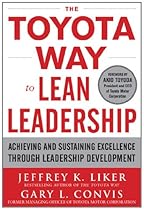I am starting to read a review copy (courtesy of McGraw-Hill) of Jeff Liker and Gary Convis’ new book, The Toyota Way to Lean Leadership. (The hot link goes to my Amazon page.)
In the spirit of one-piece-flow, I am to share key thoughts as I go rather than save everything for a thousand word review at the end.
One of the first points that comes out – in the prologue no less – is the acknowledgement that people development is a constraint to growth that you ignore at your peril.
One of the results of Toyota’s breakneck pace of growth in the first half of the last decade was that they were still making North American decisions in Japan.
They were doing this because, in the authors’ words, “…Toyota did not develop enough leaders, or did not develop leaders that it trusted sufficiently, in the North American operation to allow decisions making and problem solving to be as close to the gemba as they should have been.”
But rather than say “we grew too fast,” the President, Akio Toyoda sees the limits and the relationship:
“The problem was that the pace of growth was faster than the pace of human resource development… It is not the growth pace itself, but it is the relationship between the pace of grown and the pace of [people development].”
When traditionally trained managers think about constraints to growth, they typically think about things they can buy. “People” as a constraint comes in only as a hiring problem.
But it takes time to develop “people” into a team that thinks and moves in unison. Today’s leaders, up to this point Toyota included, underestimate both the time and the effort it takes to do that.
Any good sports team knows what it takes to build a team. So does the military. We understand the science, the psychology. But perhaps because it is difficult and sometimes messy to deal with people (and it is certainly impossible to reduce the effect of good teamwork to a stoplight report and a spreadsheet), “people development” gets delegated to HR, or people are sent to classroom training and given “certifications.” Doesn’t work, never has.
Akio Toyoda was acknowledging an uncomfortable truth – that they had fallen behind on people development and they had continued anyway, without pulling the metaphorical andon and addressing the issue as soon as it came up.
This simple insight hits at the very core of what we, as a community, need to address, and what the flag-bearing institutions in our community still need to fully embrace.
“Continuous Improvement” means “continuously improving people.”
While just about every “lean overview” I have ever seen uses some form of lip service to the concept of “people based system” everything then goes straight into describing the technical characteristics of everything but how people are developed.
What I like is that in the last couple of years the mainstream books are starting to address this topic in a meaningful way. This, of course, isn’t the first of Jeff Liker’s books to hit here. And Toyota Kata is really the first to address the mechanics of people development as thoroughly as we have addressed the mechanics of kanban.
I am liking what I am reading in this book so far, and I’ll be working to correlate what I read with other works out there plus my own experiences. This should also tie in nicely with points I want to continue to make on Bill Constintino’s presentation.
Stay tuned.

One Reply to “Leadership: Deal With The True Constraint”